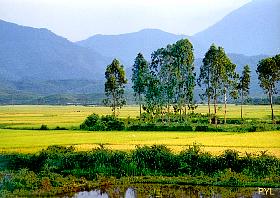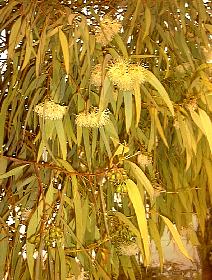
|
Eucalyptus or Gum tree 
tree of the family Myrtaceae.
Etymology: "eucalyptus" comes from Greek eu, "good" and kalypto, "cover", because petals and sepals are welded. "Gum" alludes to the red resinous gum that they exude when they are hurt.
Origin: Australia, Tasmania, Malaysia. Introduced into France in 1828.
Habitat:sour and humid soil (the photo above was made in Vietnam; the eucalyptus grows fluently in France, rather in the South). The litter of leaves is toxic to vegetation.
Hardiness: zone 8 (it supports cold until -12 °C or 10 °F).
|
Height: some species are the tallest trees of the world: the Eucalyptus regnans attained 100 metres tall! It attained records of 130 m in its original area (taller than the Redwood). Most eucalyptus in temperate climates fear frost (except some Species as the Eucalyptus niphophila). The long frost of 1985 in France burnt numerous Eucalyptus of the South of France which grew back by suckering from roots.
The bark sheds in flakes.
Persistent leaves. The young leaves or those located on suckering and low branches differ from grown-up, higher leaves: they are round and opposite, while the grown-up leaves are long, sharp and alternate. They have a colour squalid green (bluish green), especially the youngest. They contain sweet-scented essence.
 Flowers do not have petals, but an operculum which protects stamens, many ones, and is ejected when the flower is ready for insects. Flowers do not have petals, but an operculum which protects stamens, many ones, and is ejected when the flower is ready for insects.
Fruit: woody, ripe capsule at the end of one year. It contains tiny seeds, dispersed by the wind.
Uses: the fasts growth of the Eucalyptus makes a choice plant for reforestation anti-erosion. The wood does not lend itself to carpentry (it cracks), but it is used in papermaking. Its red resin is used as shoe polish. The essence of its leaves has powers disinfectant and decongestant in respiratory tract (cigarettes for the asthmatic were made). The eucalyptol is spreading at the first rains to repell the parasitic plants. |

![]()

![]()

![]()

